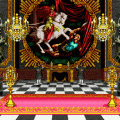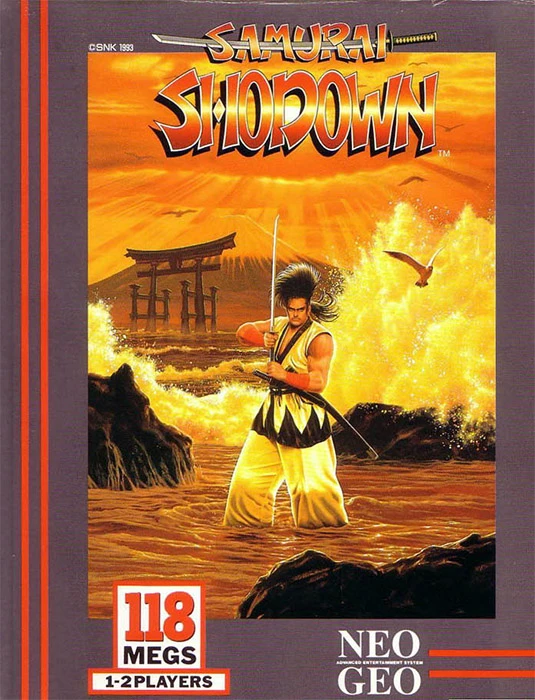Samurai Shodown (🇯🇵 Samurai Spirits) is a fighting game by SNK, released in 1993 for the Neo-Geo in arcade and console versions. It innovated with its gameplay, based on melee weapons and some fighters also using animal companions.
It is set in Japan in 1788. Despite using references to real people and events, it has a loose plot, with elements from different eras. It won several awards and its success led to the production of versions and sequels, being one of the company's most recognized franchises.
Gameplay

The main feature of Samurai Shodown is the battle system. The original Neo-Geo configuration, with 4 buttons, allowed for a weak attack and a medium attack with a sword or kicks. Two buttons together result in a strong blow.
The player must choose when to apply strong blows, because although they take more energy from the opponent, they are slow, leaving a period of open guard. The character can run or retreat quickly, with two taps in the same direction.
The pace is fast, and well-placed blows are more important than combos or specials. During the fight, there is a referee in the background, signaling blows with white and red flags. The scenarios are full of animation, and there are interactive parts, cut off when receiving blows. There are also characters that interfere in the battle (according to SNK's description, the "Edo Express Delivery"), throwing bombs or dropping items such as chickens and money boxes.
When the sword button is pressed with fighters nearby, they enter a "power contest" mode. The button must be pressed repeatedly, and whoever loses is disarmed — but the weapon remains on the ground, and can be recovered.
There is also a rage bar (ikari or 怒) at the bottom of the screen, which fills up as the fighter receives blows. When it is full, the "rage explosion" occurs: the character changes color, the text POW appears highlighted, and his blows become stronger.
The zoom system is similar to that used in 1992's Art of Fighting, but improved, with smoother transitions. It allows you to see the entire scene when the fighters move away, and closes in on the characters when they get closer.
Development history
The programming team for Samurai Shodown consisted of a combination of SNK veterans and former Capcom employees. The executive producer was Eikishi Kawasaki, while production is credited to the codename "Rocket Queen".
There is a high level of violence, with blood and deaths. Enemies hit by a final strong blow can be cut in half or pierced, spurting blood – scenes with an effect amplified by realistic screams. When the fatality occurs, the following cutscene between fights shows the corpse being removed from the arena among straw.
Great care was taken in the setting, faithful to the end of feudal Japan – or to what the popular imagination expects of such a setting. Sound is of great importance, with traditional instruments such as the shakuhachi and shamisen, and narration in Japanese by actor Masaki Usui. To emphasize the drama, strong blows activate a moment of slow motion, most noticeable in the final blow of the fight.
Several characters have a connection to someone real. The main antagonist, Amakusa, is inspired by Amakusa Shirō, leader of the Shimabara Revolt, an uprising of Japanese Catholics against the Tokugawa Shogunate that took place between 1637 and 1638. Like his fictional version, he was killed by shogunate officials — and according to legend, he promised to return in 100 years to take revenge.
Haohmaru was loosely inspired by Miyamoto Musashi, a legendary samurai who never lost a battle. Ukyo was based on Sasaki Kojirō, a swordsman who was Musashi's most renowned rival (and at whose hands he died in a duel in 1612). Hanzo was inspired by the ninja of the same name, who lived in Japan between 1541 and 1596.
The plot is not tied to the dates of historical events, although it uses them. There are characters from different eras, in a form of creative freedom.
Reception and legacy
Samurai Shodown achieved great success even competing with established franchises such as Street Fighter and Mortal Kombat. It received awards such as "Best Game of the Year 1993" and "Best Fighting Game of the Year 1993" from Gamest and EGM magazines.

The success led to the production of several ports and sequels. Between 1993 and 1995, versions were released for consoles such as Mega Drive, Super Nintendo, 3DO, Sega CD and Game Gear. Almost all were made by Takara, with the exception of 3DO (Crystal Dynamics) and Sega CD (Funcom). They suffered different levels of censorship, including the removal of fatalities and discoloration of blood.
Since almost no video game came close to the graphical power of the Neo-Geo back then, there were also technical cuts. The most common were the elimination of the zoom and Earthquake, a character who takes up almost the entire screen. The most faithful were those for 3DO and PlayStation – released in 1998 as part of the Samurai Spirits Kenkaku Shinan package.
The home version (Neo-Geo AES) had the death animation and the color of the blood jets removed. References to the rival's death were also edited out in the interim scenes and dialogues after the fights. This caused dissatisfaction among some customers, since one of the premises of the Neo-Geo was fidelity between AES and MVS (arcade). The cuts came at a time of public discussion about the increasing violence in video games.
The game was re-released in 2007 for the Virtual Console on the Wii, and in the compilation SNK Arcade Classics Vol. 1, also for PlayStation 2 and PSP.
Plot
Moments before being executed by the forces of the Tokugawa Shogunate, Shiro Tokisada Amakusa swears revenge. He makes a pact with the demon Ambrosia and returns using the body of Shinzo, son of the ninja Hanzo Hattori, to fulfill his promise. Warriors from various parts of Japan appear to fight him or take advantage of the moment of instability.
Plot according to the official website:
"Plagues of unknown origin, strange phenomena, repeated outbreaks of war: it was enough to cause panic and throw the population into despair.
But someone smiled as they watched the chaos unfold that tore the world apart. For this "man", one day massacred by the forces of the Tokugawa Shogunate, hatred is all he has – besides his new powers of darkness.
This "man", Tokisada Amakusa, released his forces from beyond and spread a false religion in an attempt to lead the world to ruin.
But in the midst of such calamities, there were still warriors who would put their beliefs to the test. These warriors with different motivations and beliefs converge as if united by battle, making their way to the source of chaos."
Soundtrack
The Samurai Shodown soundtrack was released in Japan on CD by Pony Canyon. In addition to the game’s music, the 46-track disc also features the voices of the characters.
- Stillness and Motion Stillness and Motion • Tate Norio
- Stillness and Motion - Short • Tate Norio
- Twelve Warriors • Tate Norio
- Whereabouts • Tate Norio
- Song of Men - Sun • Tate Norio
- Song of Men - Moon • Tate Norio
- Wild Strike I • Tate Norio
- Bamboo Thicket • Tate Norio
- Shadow • Tate Norio
- Bad Omen • Tate Norio
- Tuna • Tate Norio
- Nature's Banquet • Tate Norio
- Concentration • Tate Norio
- Foreign Woman • Tate Norio
- Foreigner • Tate Norio
- Demon • Tate Norio
- Magatama • Tate Norio
- Earth • Tate Norio
- King Tiger • Tate Norio
- Victorious Battle • Tate Norio
- Wild Strike II • Tate Norio
- Heartbeat • Tate Norio
- Flames • Tate Norio
- Darkness • Tate Norio
- Scream • Tate Norio
- Peace • Tate Norio
- Revolutionary Woman • Tate Norio
- The Festival Performed • Tate Norio
- Call for an Encore ~ Performance End • Tate Norio
Images
X-ray
- Development
- SNK
- Production
- Eikichi Kawasaki
- Players
- 2 (single-player, multi-player)
- Genre
- Fighting
- Cast
- Characters
- Haohmaru, Gen-An, Charlotte, Ukyo Tachibana, Hanzo Hattori, Jubei Yagyu, Galford, Earthquake, Wan-Fu, Tam Tam, Nakoruru, Kyoshiro Senryo, Shiro Tokisada Amakusa
Releases
See also franchise page Samurai ShodownNeo-Geo
See deals on eBay

































